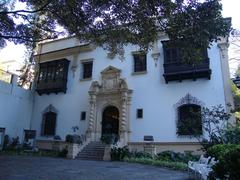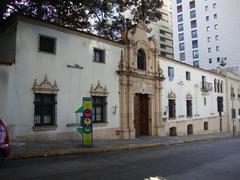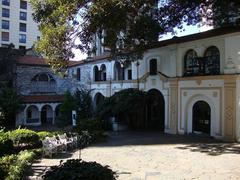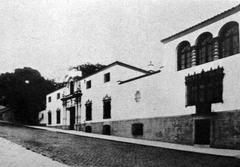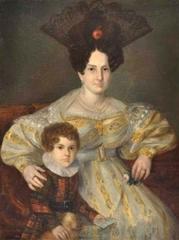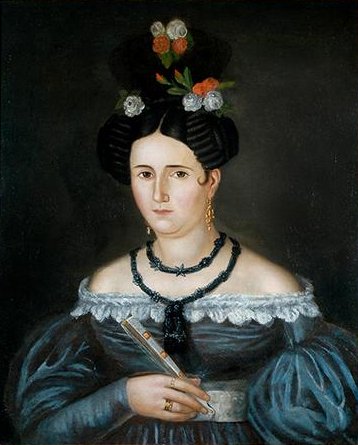
Museum Of Hispanic American Art Isaac Fernández Blanco
Museum of Hispanic American Art Isaac Fernández Blanco: Visiting Hours, Tickets, and Complete Guide to Buenos Aires Historical Sites
Date: 14/06/2025
Introduction
The Museo de Arte Hispanoamericano Isaac Fernández Blanco is a cultural landmark in Buenos Aires, Argentina, dedicated to preserving and showcasing the rich artistic heritage of Hispanic America. Housed in the architecturally significant Palacio Noel, the museum offers an immersive journey through colonial and neocolonial art, including silverwork, textiles, paintings, and decorative objects dating from the 16th to 19th centuries. Founded on the private collection of Isaac Fernández Blanco, the museum has grown into a premier institution for both art enthusiasts and those curious about Latin America’s colonial past (Buenos Aires Free Walks, Wikipedia, Buenos Aires Government).
This detailed guide provides essential information for visitors—covering museum history, collection highlights, visiting hours, ticketing, accessibility, guided tours, and tips for exploring nearby Buenos Aires historical sites.
Table of Contents
- Origins of the Museum and Its Founder
- Development of the Collection and the Move to Palacio Noel
- Collection Highlights and Significance
- Visiting Information
- Palacio Noel: Architecture and Historical Context
- Practical Travel Tips
- Frequently Asked Questions (FAQ)
- Summary & Recommendations
- References
Origins of the Museum and Its Founder
The museum was established thanks to the passion and vision of Isaac Fernández Blanco, an Argentine engineer and avid collector born in 1867. His dedication to preserving Hispanic-American art, especially from the colonial period, led him to assemble a vast collection of paintings, silverware, religious artifacts, textiles, and decorative objects. His private museum, initially opened to the public in 1921, quickly gained recognition within Buenos Aires’ cultural scene (Buenos Aires Free Walks).
In 1922, Fernández Blanco sold his property and collection to the City of Buenos Aires, ensuring its long-term preservation and accessibility. The museum, originally located in his home, was officially reopened as the Museo de Arte Colonial and eventually found its permanent home in Palacio Noel (Wikipedia).
Development of the Collection and the Move to Palacio Noel
In 1943, the museum relocated to Palacio Noel in the Retiro neighborhood. Designed by architect Martín Noel, this mansion is a masterpiece of neocolonial architecture, featuring arcaded courtyards, ornate balconies, and lush gardens that evoke the grandeur of colonial Latin America (La Nación, Buenos Aires Ciudad).
Following Fernández Blanco’s death, the museum continued to expand through donations, purchases, and bequests, becoming one of the world’s foremost repositories of Spanish-American viceregal art (MiBsAs).
Collection Highlights and Significance
Today, the museum’s collection features over 6,000 objects, including:
- Colonial Silverwork: Over 2,000 pieces from Peru and the Río de la Plata, including religious and domestic items.
- Cuzco School Paintings: Vivid works known for gold leaf and rich iconography.
- Furniture and Decorative Arts: Luxurious colonial-era pieces from Spanish America and Portuguese Brazil.
- Religious Artifacts: Sculptures, altarpieces, and liturgical vestments from Lima, Quito, and Jesuit missions.
- Peinetones: Large, ornate tortoiseshell combs unique to 19th-century Buenos Aires.
- Numismatics and Documents: Coins, medals, and historical records from the colonial period (Wikipedia; Buenos Aires Government).
The museum also hosts rotating exhibitions, contemporary art dialogues, and educational programs, making it a dynamic center for research and public engagement (Buenos Aires Tourism).
Visiting Information
Visiting Hours
- Tuesday to Friday: 1:00 pm – 6:00 pm
- Saturdays, Sundays, and Public Holidays: 1:00 pm – 5:00 pm
- Closed on Mondays
- Hours may vary during holidays or special events; check the official website for updates (Buenos Aires Tourism).
Tickets & Admission
- General Admission: Often free, but some special exhibitions may require a ticket (typically ARS 50–150).
- Discounts: Available for students, seniors, and children.
- Purchasing: Tickets can be purchased at the entrance or online via the official website.
- Reservations: Time-slot bookings may be required during peak periods or events.
Accessibility
- Palacio Noel is equipped with ramps and elevators, though some historic areas may have steps or uneven surfaces.
- Visitors with mobility challenges should contact the museum in advance to arrange accommodations.
Guided Tours & Events
- Regular guided tours are available in Spanish and, occasionally, English. Advance booking is recommended.
- The museum hosts concerts, lectures, and workshops, especially during spring and summer. Check the museum’s calendar for updates.
Getting There & Nearby Attractions
- Address: Suipacha 1422, Retiro, Buenos Aires.
- Subway: Carlos Pellegrini (Line B), 9 de Julio (Lines C & D).
- Bus: Multiple lines, including 59, 67, and 152.
- Nearby Sites: Plaza San Martín, Kavanagh Building, Museo Nacional de Bellas Artes, Recoleta Cemetery (Buenos Aires Tourism Portal).
Photography
- Photography without flash is allowed in most areas; tripods are not permitted.
- The gardens, courtyards, and Spanish-style interiors are popular spots for photos.
Palacio Noel: Architecture and Historical Context
Palacio Noel is one of Buenos Aires’ finest examples of neocolonial architecture, designed by Martín Noel between 1920 and 1924. The palace incorporates elements from Spanish Baroque, Lima, Cuzco, and Jesuit mission styles, including:
- Balconies and Galleries: Inspired by Lima’s colonial mansions.
- Andalusian Gardens: Featuring native and imported flora.
- Authentic Colonial Details: Antique doors, altarpieces, and balconies from across Latin America (Buenos Aires Ciudad).
- Terraced Layout: Built on a natural slope, offering serene views amid the city’s urban landscape.
The palace’s design not only complements the museum’s collection but also stands as a cultural statement reflecting Argentina’s early 20th-century heritage revival (La Nación).
Practical Travel Tips
- Best Time to Visit: Fall (March–May) and spring (September–November) offer pleasant weather and fewer crowds.
- Duration: Plan for 1.5–2 hours to explore the museum; allow extra time for special exhibitions or events.
- Language: Most labels are in Spanish; guided tours or translation apps are helpful.
- Amenities: Restrooms, cloakroom, and a gift shop are available; no café on site, but nearby dining in Retiro and Recoleta.
- Safety: The area is safe and well-trafficked, but standard travel precautions are advised.
- Families: Gardens and cultural events are suitable for all ages.
Frequently Asked Questions (FAQ)
Q: What are the visiting hours?
A: Tuesday to Friday, 1:00 pm–6:00 pm; weekends and holidays, 1:00 pm–5:00 pm; closed Mondays.
Q: Is admission free?
A: General admission is often free; special exhibitions may have a fee.
Q: Are guided tours available?
A: Yes, in Spanish and sometimes English. Book in advance where possible.
Q: Is the museum wheelchair accessible?
A: Yes, with some limitations due to the historic building. Contact the museum for specific needs.
Q: Where is the museum located?
A: Suipacha 1422, Retiro, Buenos Aires, near major attractions.
Q: Can I take photographs?
A: Yes, photography without flash is allowed in most areas.
Summary and Recommendations
The Museo de Arte Hispanoamericano Isaac Fernández Blanco, set within the stunning Palacio Noel, is a cultural treasure in Buenos Aires. Its unparalleled collection of colonial silverwork, paintings, textiles, and decorative arts offers insights into the artistic traditions and history of Hispanic America. The museum’s accessible location, affordable admission, and diverse programming make it an essential stop for anyone exploring Buenos Aires historical sites.
To make the most of your visit:
- Check current visiting hours and event schedules.
- Consider a guided tour for deeper understanding.
- Explore the palace’s gardens and architectural features.
- Visit nearby landmarks such as Plaza San Martín and Recoleta Cemetery.
Stay informed by visiting the museum’s official website, downloading the Audiala app for audio guides, and following their social media for updates on exhibitions and events.
References
- Buenos Aires Free Walks
- La Nación
- Buenos Aires Tourism
- Buenos Aires Tourism Portal
- Wikipedia
- Welcome Argentina
- Buenos Aires Government

